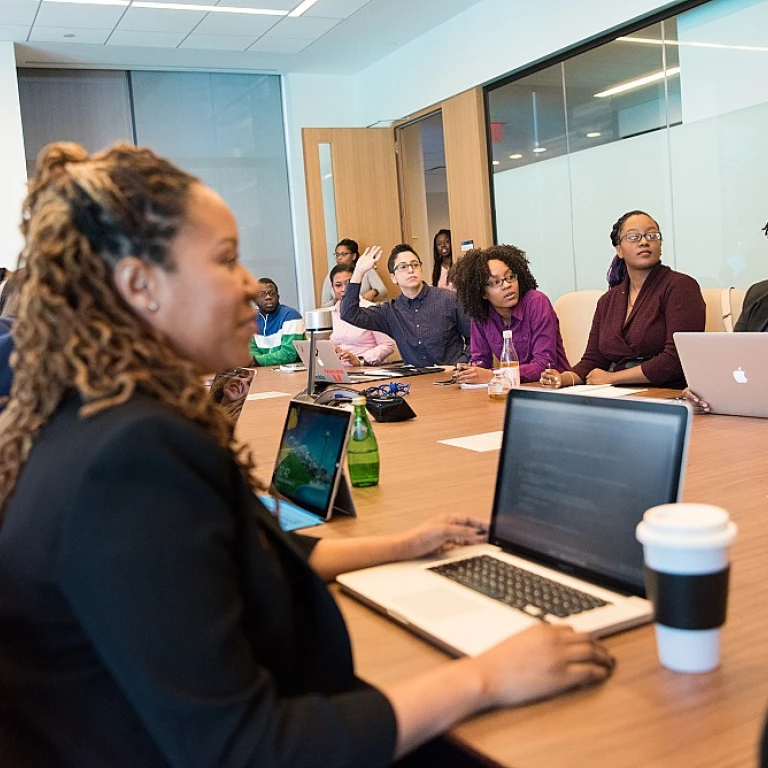Understanding Bilingual Leadership Resources
Exploring Bilingual Leadership Resources
In the realm of leadership development, accessing resources that cater to both Arabic and English speakers is crucial for fostering effective bilingual leaders. With the increasing diversity in workplaces and educational institutions, understanding how to leverage these resources can make a significant difference.
For individuals navigating bilingual leadership, it's essential to consider a variety of resources that cater to different language proficiencies. Whether you're a parent seeking guidance for your child's education in a multilingual school district or a business leader aiming to enhance your team's communication, the availability of comprehensive resources can be a game-changer.
Many educational programs and leadership development initiatives now offer materials in both Arabic and English. These include:
- Language Proficiency Tests: Tools that assess language skills to ensure leaders can communicate effectively in both languages.
- Parent Guides: Resources designed to help parents navigate the educational landscape, especially in areas like New York State where multilingual learners are prevalent.
- Leadership Guides: Comprehensive PDFs that offer strategies and best practices for effective leadership across different cultural contexts.
Moreover, institutions like charter schools and state education programs are increasingly recognizing the importance of bilingual resources. They provide special education materials and parent notifications in multiple languages to accommodate diverse communities.
For those interested in diving deeper into the topic, exploring engaging training methods can offer additional insights into mastering leadership skills in a bilingual context. This not only benefits leaders but also supports the overall success of students and professionals alike.
As we progress, understanding cultural nuances and developing essential leadership skills will further enhance the effectiveness of bilingual leaders, ensuring they can overcome language barriers and lead with confidence.
Cultural Nuances in Leadership Styles
Bilingual Leadership: Bridging Cultural Norms
Navigating leadership within bilingual environments in Arabic and English requires an understanding of diverse cultural nuances. This understanding is pivotal for leaders who wish to operate effectively across different cultural contexts. In many bilingual settings, especially in regions with high Arabic and English language proficiency such as New York State, the cultural expectations regarding leadership can vary widely. For instance, while some cultures might emphasize a hierarchical structure where decisions are made from the top down, others may value collective decision-making processes that engage team members at every level. Leaders operating in multilingual environments should also consider the impact of education systems, such as state education and charter schools, on cultural perceptions of authority and leadership. In schools and business offices, different cultural backgrounds can influence how leaders are perceived and how their directives are received. It’s not uncommon for a York State school district to embrace diverse approaches to leadership, fostering an inclusive atmosphere where leaders respect and incorporate cultural nuances. Understanding these cultural differences is not merely about avoiding miscommunication; it’s about facilitating a more inclusive work and educational environment. Resources such as language proficiency tests and multilingual learner programs are essential tools for leaders. These resources help in evaluating how well individuals can adapt to a bilingual education or work environment and ensure that no missteps occur due to cultural misunderstandings. Furthermore, leveraging a parent guide in both Arabic and English can provide parents and guardians with crucial insights into how leadership is exercised within schools. Engaging parents provides an additional layer of support, aiding leaders in comprehending family dynamics and educational expectations. For innovative approaches to leadership development that cater to these diverse cultural needs, explore this resource. By utilizing such guides and embracing best practices, modern leaders can effectively navigate the complexities of cultural nuances in a bilingual leadership landscape.Essential Skills for Effective Leadership
Enhancing Leadership Capabilities
Cultivating effective leadership skills is essential for navigating bilingual environments. Whether you're working within a business setting or involved in an educational program such as youth leadership, mastering a range of leadership capabilities ensures success. These skills are crucial for multilingual learners and leaders who aim to succeed at various levels, from school districts to corporate offices.- Communication Proficiency: A leader should excel in both English language proficiency and any other language required in their context. This ensures clear communication with all team members and stakeholders, from school district staff to business partners. Enhancing language skills through education programs can support leaders to communicate more effectively in both languages.
- Cultural Sensitivity: Understand cultural nuances, as addressed earlier, to create an inclusive work or school environment that encourages diverse perspectives. Leaders who are culturally aware are better equipped to manage teams in multicultural settings, especially in states with diverse populations like New York.
- Decision-Making and Problem-Solving: Leaders need to make informed decisions swiftly, whether they're navigating state education regulations or overseeing a business project. Accessing resources such as a leadership guide can provide insights into best practices for effective decision-making.
- Emotional Intelligence: Developing emotional intelligence is key to managing relationships successfully. Leaders who are empathetic and self-aware foster positive work environments, increasing the performance and satisfaction of their teams.
Overcoming Language Barriers in Leadership
Bridging Language Gaps for Stronger Leadership Communication
Effectively overcoming language barriers is crucial in leadership, especially in multilingual environments where communication serves as the cornerstone of leadership success. Leaders must navigate these challenges without compromising clarity and cohesion in a way that respects both Arabic and English language nuances. Firstly, leaders should embrace language proficiency initiatives. Programs in educational settings like charter schools and high schools often offer English language learning resources. These can be invaluable for aspiring leaders looking to improve their bilingual abilities. State education programs also frequently provide language proficiency tests to help identify areas needing improvement. Such opportunities should be seized to enhance communication at every level. Youth leadership programs often include special education resources, teaching leaders how to communicate effectively with diverse groups. By utilizing a guide PDF format that presents bilingual strategies, businesses can empower their staff to bridge language differences and foster an office environment that embraces multilingualism with ease. Beyond academic resources, workplaces can also benefit from parent guides that emphasize the importance of family support in language learning. Parents play a key role, acting as partners in education, ensuring students' success. They're often instrumental in ensuring that their children gain the necessary skills to excel in leadership roles, particularly for multilingual learners. Finally, leaders can create a more inclusive environment by making use of accessible language resources. Utilizing business-specific language training programs can be particularly effective in larger organizations where time and resources are often limited. Continuous education and language skills training offer a practical way to bypass communication obstacles and promote stronger leadership communication across various state and school districts. In conclusion, developing robust leadership skills necessitates addressing language barriers head-on. By focusing on targeted language education programs and involving parents, leaders can foster an adaptive and responsive leadership style that resonates with both Arabic and English speakers alike. The calculated investment in language proficiency underscores a commitment to inclusive leadership and champions diversity as a powerful component of organizational success.Case Studies: Successful Bilingual Leaders
Bilingual Leaders: Paths to Success
In the ever-evolving landscape of leadership, the ability to navigate both language and culture is becoming increasingly vital. Bilingual leaders, especially those proficient in both Arabic and English, often possess a unique competitive edge. By leveraging available resources, such as bilingual guides and language programs, they effectively bridge the gap between diverse cultures and work environments. A crucial aspect of bilingual leadership is the ability to understand and respect cultural nuances. This skill is paramount in crafting strategies that resonate with different audiences, whether at the state level, within a school district, or in a business office. Leaders who are adept in English and another language, such as Arabic, bring invaluable perspectives to the table, enhancing communication and fostering collaboration. Bilingual leaders often engage in programs that focus on multilingual education. These programs support not only language proficiency but also help leaders gain insights into strategies for overcoming language barriers. In practical terms, this can translate into more effective communication with stakeholders like parents, educators, and business partners. Imagine a scenario where bilingual leaders work within charter schools or special education settings. Here, they apply their language and cultural knowledge to develop resources family members can use, such as a parent guide in multiple languages. Additionally, they contribute to the creation of resources like guide PDFs, which serve as accessible tools for leader engagement across cultural and linguistic divides. Successful bilingual leaders also know the importance of adaptability. Having to operate within diverse environments, they utilize guides and resources to continuously expand their knowledge and skills. Engagement in youth leadership programs or proficiency tests can serve to further hone their leadership capabilities and help them excel in their roles. Through a combination of educational background, like that found in high school programs and professional development initiatives, bilingual leaders not only thrive but also create inclusive environments where others can succeed. By focusing on these best practices, leaders can ensure they meet the challenges of today's multilingual and multicultural landscape, all while promoting growth on personal, community, and organizational levels.Accessing and Utilizing a Leadership Guide in Arabic-English PDF
Accessing Bilingual Leadership Resources
In today's interconnected world, accessing bilingual leadership resources is crucial for leaders who operate in multilingual environments. One effective way to bridge the language gap is through comprehensive guides available in both Arabic and English. These resources can be especially beneficial for leaders working in diverse settings, such as international business, education, and community programs.
Utilizing a Leadership Guide in PDF Format
PDF guides are a practical tool for leaders seeking to enhance their skills while accommodating language preferences. They offer the flexibility to access information at any time, whether at the office or on the go. A bilingual leadership guide in PDF format can serve as a valuable reference, providing insights into cultural nuances and essential leadership skills discussed in earlier sections.
Benefits of a Bilingual Leadership Guide
- Comprehensive Content: These guides often cover a wide range of topics, from language proficiency to best practices in leadership.
- Accessibility: With a PDF format, leaders can easily share resources with colleagues and team members, fostering a collaborative learning environment.
- Adaptability: Leaders can tailor their learning experience to their specific needs, whether they are focusing on youth leadership or managing multilingual teams.
Finding the Right Resources
For those in states like New York, where diverse communities are prevalent, accessing a bilingual guide can be an invaluable asset. Educational institutions, such as school districts and charter schools, often provide resources that support multilingual learners and their families. These resources help parents and students navigate the educational system, ensuring that everyone has the opportunity to succeed.
State education departments may also offer guides that align with policies like the Every Student Succeeds Act (ESSA), which emphasize the importance of language proficiency and inclusive education. By leveraging these resources, leaders can effectively address language barriers and promote a culture of inclusivity in their organizations.







